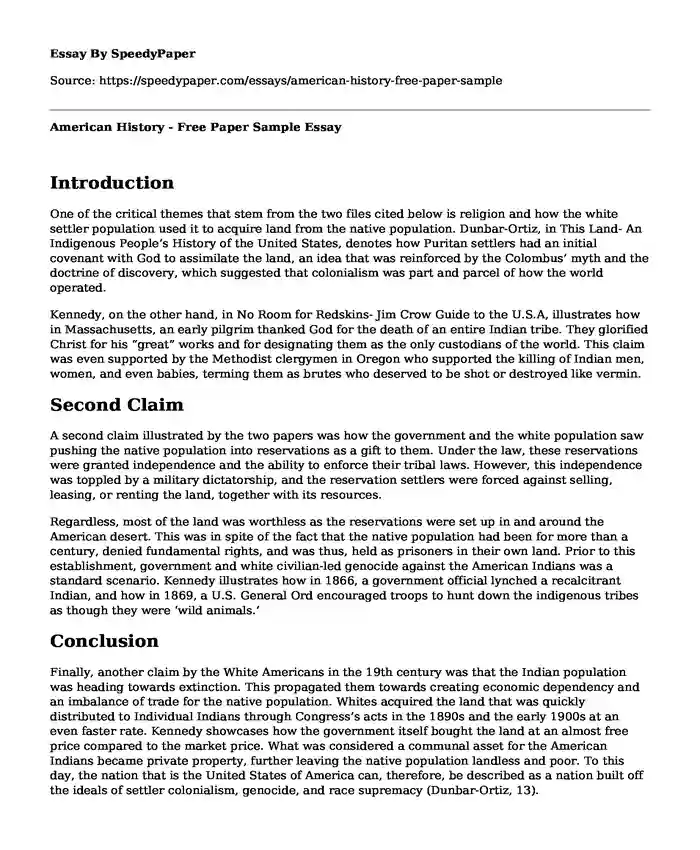
| Type of paper: | Essay |
| Categories: | Sociology Religion Society American history |
| Pages: | 2 |
| Wordcount: | 530 words |
Introduction
One of the critical themes that stem from the two files cited below is religion and how the white settler population used it to acquire land from the native population. Dunbar-Ortiz, in This Land- An Indigenous People’s History of the United States, denotes how Puritan settlers had an initial covenant with God to assimilate the land, an idea that was reinforced by the Colombus’ myth and the doctrine of discovery, which suggested that colonialism was part and parcel of how the world operated.
Kennedy, on the other hand, in No Room for Redskins- Jim Crow Guide to the U.S.A, illustrates how in Massachusetts, an early pilgrim thanked God for the death of an entire Indian tribe. They glorified Christ for his “great” works and for designating them as the only custodians of the world. This claim was even supported by the Methodist clergymen in Oregon who supported the killing of Indian men, women, and even babies, terming them as brutes who deserved to be shot or destroyed like vermin.
Second Claim
A second claim illustrated by the two papers was how the government and the white population saw pushing the native population into reservations as a gift to them. Under the law, these reservations were granted independence and the ability to enforce their tribal laws. However, this independence was toppled by a military dictatorship, and the reservation settlers were forced against selling, leasing, or renting the land, together with its resources.
Regardless, most of the land was worthless as the reservations were set up in and around the American desert. This was in spite of the fact that the native population had been for more than a century, denied fundamental rights, and was thus, held as prisoners in their own land. Prior to this establishment, government and white civilian-led genocide against the American Indians was a standard scenario. Kennedy illustrates how in 1866, a government official lynched a recalcitrant Indian, and how in 1869, a U.S. General Ord encouraged troops to hunt down the indigenous tribes as though they were ‘wild animals.’
Conclusion
Finally, another claim by the White Americans in the 19th century was that the Indian population was heading towards extinction. This propagated them towards creating economic dependency and an imbalance of trade for the native population. Whites acquired the land that was quickly distributed to Individual Indians through Congress’s acts in the 1890s and the early 1900s at an even faster rate. Kennedy showcases how the government itself bought the land at an almost free price compared to the market price. What was considered a communal asset for the American Indians became private property, further leaving the native population landless and poor. To this day, the nation that is the United States of America can, therefore, be described as a nation built off the ideals of settler colonialism, genocide, and race supremacy (Dunbar-Ortiz, 13).
Works Cited
Dunbar-Ortiz, Roxanne. An Indigenous People’s History of the United States. ReVisioning
American History. Beacon Press. 2014. Boston, Massachusetts.
Kennedy, Stetson. Jim Crow Guide to the U.S.A. The Laws, Customs, and Etiquette
Governing the Conduct of Non-Whites and Other Minotrities as Second-Class Citizens. The University of Alabama Press. 1990. Tuscaloosa, Alabama.
Cite this page
American History - Free Paper Sample. (2023, Nov 25). Retrieved from https://speedypaper.com/essays/american-history-free-paper-sample
Request Removal
If you are the original author of this essay and no longer wish to have it published on the SpeedyPaper website, please click below to request its removal:
- Causes of Bullying in Our Free Essay
- Free Essay Sample on Developing a Health Advocacy Campaign
- Free Paper Example Containing the Appeal to Amend the Federal Licensing System
- Free Essay. Propaganda in the Baroque Period
- Essay on Personality & Jealousy: Low Self-Esteem & Gender Differences
- Free Paper Sample: Delivery of Bad News
- Jesus' Condemnation - Paper Example
Popular categories




